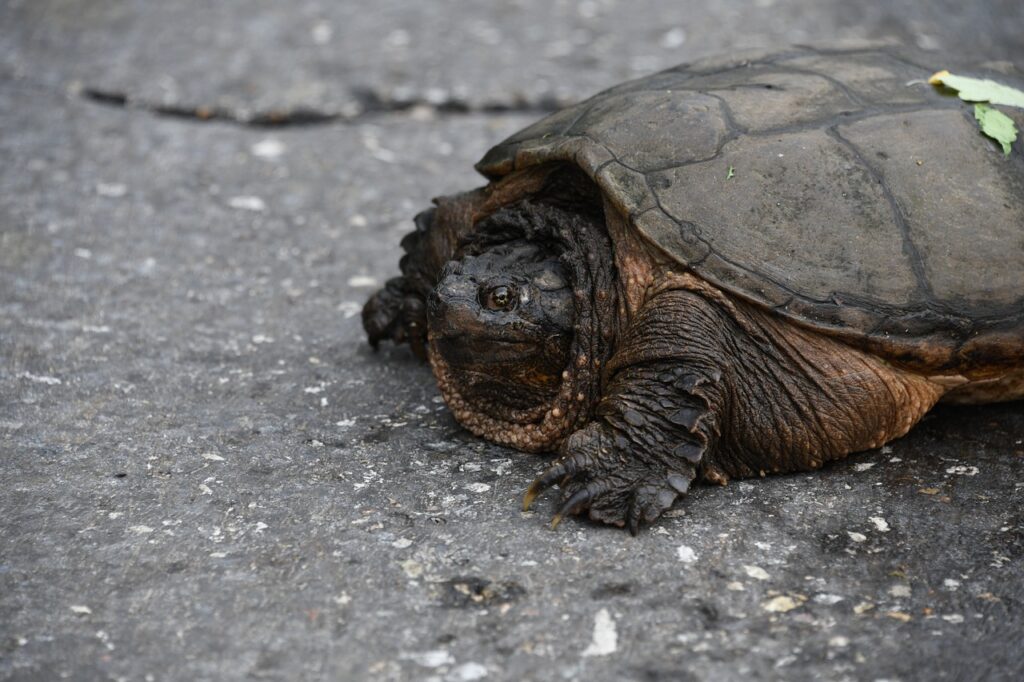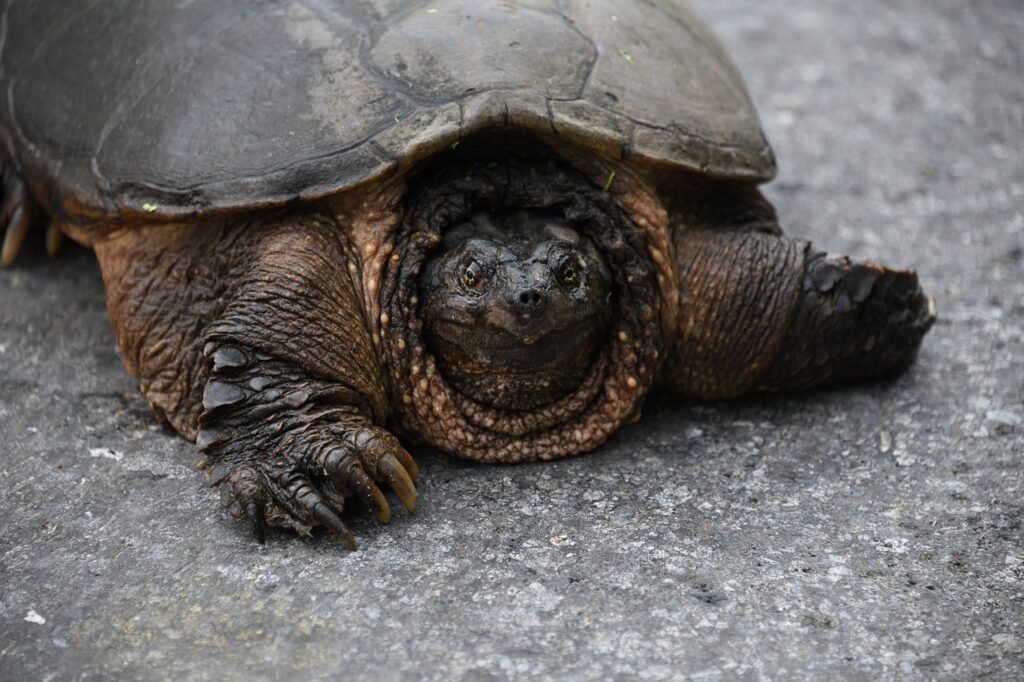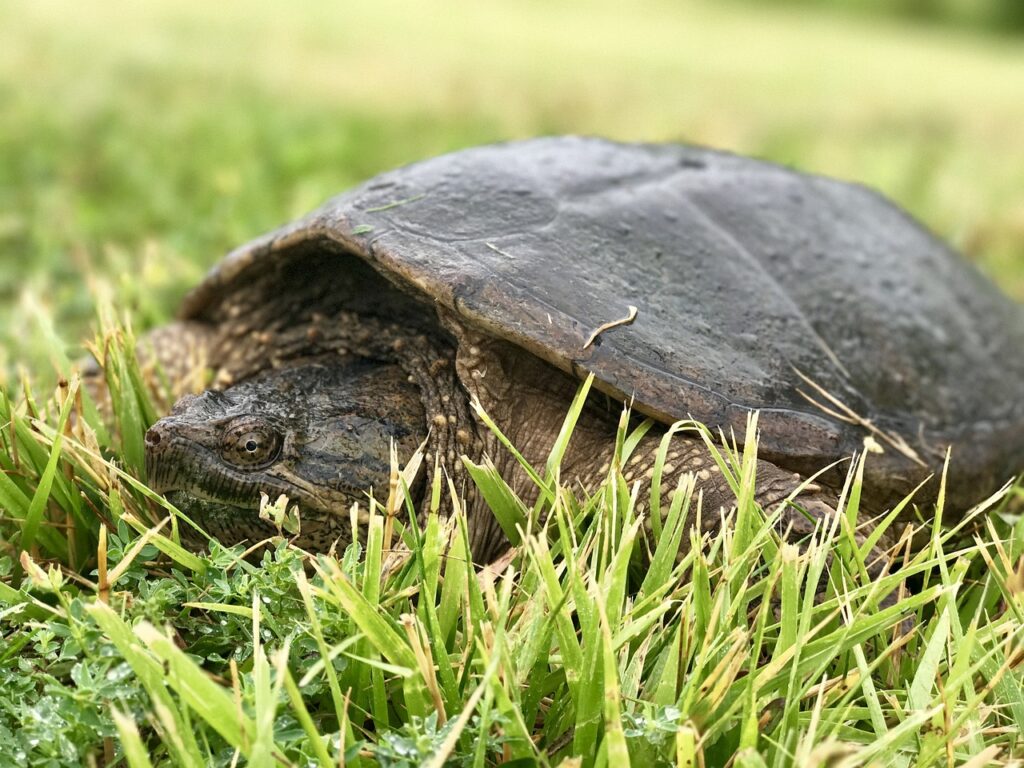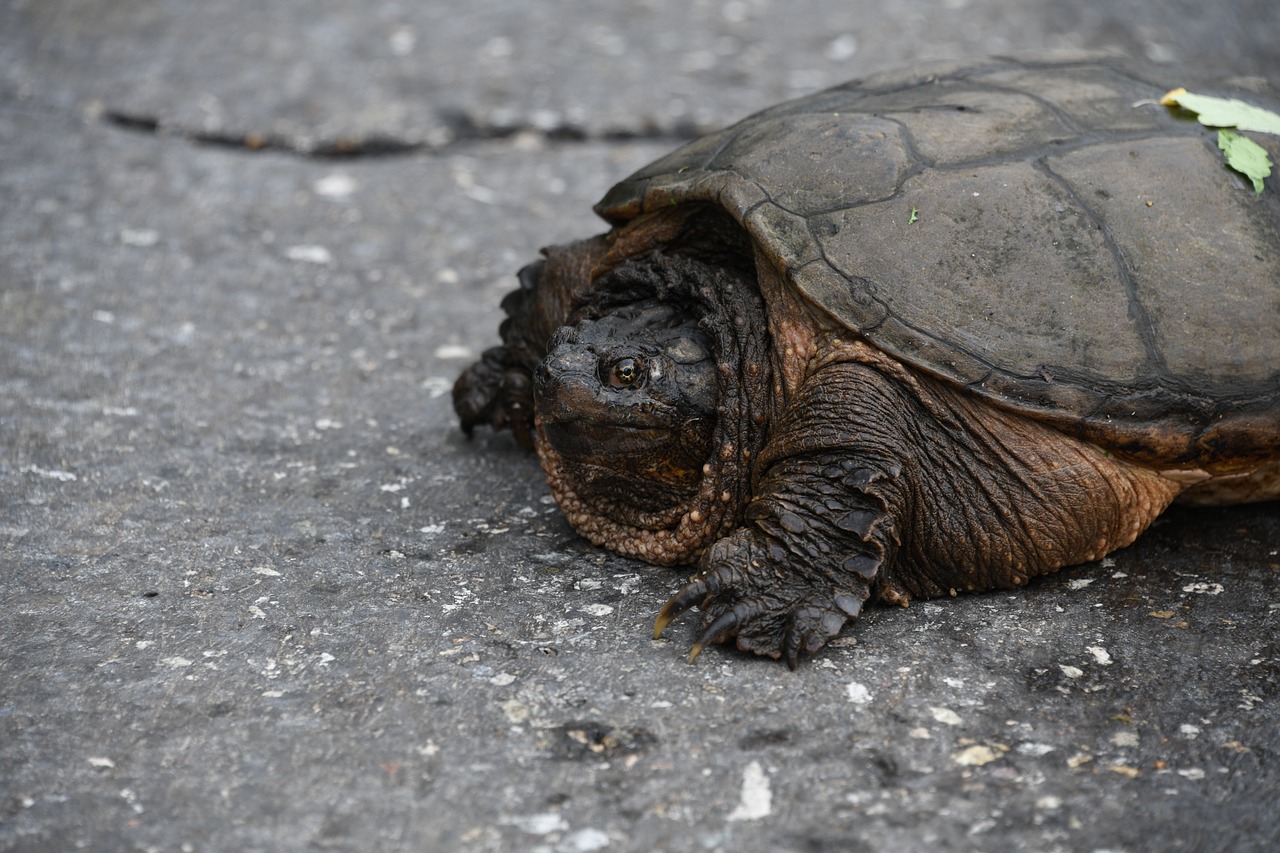Have you ever come across a peculiar creature while exploring a nearby pond or wetland? With its impressive size and fearsome reputation, the snapping turtle is certainly a unique sight to behold. In this article, we will provide you with essential tips and techniques on how to identify these fascinating creatures. From their distinct physical features to their behavior in their natural habitat, you will soon become an expert at recognizing these incredible reptiles. So, grab your notepad and get ready to embark on this educational journey to unravel the mysteries of the snapping turtle!
Appearance
Shell
The shell of a snapping turtle is one of its most defining features. It is hard and bony, providing excellent protection for the turtle’s body. The shell is divided into two parts: the carapace on top and the plastron on the bottom. The carapace is typically dark brown or black in color and has a rough texture, while the plastron is lighter in color and smoother. The shell can also have algae or mud on it, which helps with camouflage.
Head
The head of a snapping turtle is large and triangular-shaped, with a beak-like mouth. The jaws are incredibly strong and can deliver a powerful bite. The skin on the head is rough and can have a slightly wrinkled appearance. Snapping turtles have two small eyes positioned on the sides of their head, allowing them to have a wide field of vision. Their eyes have a yellow or brown coloration.
Limbs
Snapping turtles have four limbs, each ending in five clawed toes. The limbs are strong and well-suited for both walking on land and swimming in water. The front limbs are slightly shorter and have more muscular development compared to the hind limbs. The toes on the front limbs are also shorter and stouter than those on the hind limbs. The claws on the toes are sharp and can be used for digging, gripping prey, or defending against threats.
Tail
The tail of a snapping turtle is long and thick, tapering towards the end. It is covered in rough, scaly skin. The tail is used for swimming and acts as a rudder, helping the turtle move through water with ease. On the underside of the tail, there may be small spines or ridges. The tail can also be used for defense and can deliver a painful whip-like strike when threatened.
Coloration
The coloration of snapping turtles can vary depending on their age, habitat, and the environment they live in. Generally, they have a dark brown or black color for their shells, providing excellent camouflage in murky waters. The skin on their head, neck, and limbs can range from gray to brown, with some individuals having greenish hues. The coloration can also change depending on factors such as temperature, sunlight exposure, and diet.
Behavior
Aggression
Snapping turtles are known for their aggressive behavior, especially when they feel threatened or cornered. They have a strong bite and can inflict serious harm if they perceive a threat. It is important to give these turtles their space and avoid any unnecessary interactions. If you encounter a snapping turtle, it is best to observe from a safe distance and not attempt to handle or provoke it.
Feeding
Snapping turtles are opportunistic feeders and have a diverse diet. They are primarily carnivorous and will eat a variety of prey, including fish, amphibians, birds, small mammals, and even other turtles. They are also known to scavenge on carrion and consume plant material such as aquatic vegetation. Snapping turtles have a powerful bite and can efficiently capture prey by luring them close or ambushing them.
Habitat
Snapping turtles can be found in various freshwater ecosystems, including lakes, rivers, ponds, and swamps. They prefer habitats with abundant vegetation, submerged logs, and rocks, which provide hiding places and basking spots. Snapping turtles spend most of their time in the water, but they will frequently venture onto land to bask in the sun or lay eggs. They are well adapted to both aquatic and terrestrial environments.
Activity Patterns
Snapping turtles are most active during the warmer months, from early spring to late fall. They are diurnal animals, meaning they are active during the day, although they may also exhibit some nocturnal behavior. They spend a significant amount of time basking in the sun to regulate their body temperature. Snapping turtles can be seen swimming or walking along the bottom of the water, searching for food or suitable nesting sites.
Reproduction
Snapping turtles have a unique reproductive process. Females typically reach sexual maturity at around 10 to 15 years of age. During the breeding season, which usually occurs in the spring or early summer, females will leave the water and travel to find suitable nesting sites. They dig a hole in the ground using their hind limbs and lay a clutch of eggs, which they cover and leave to incubate. The eggs will hatch after an incubation period of about 9 to 18 weeks, depending on environmental conditions.

Habitat
Freshwater Ecosystems
Snapping turtles are primarily found in freshwater ecosystems, such as lakes, rivers, and ponds. These habitats provide them with a diverse range of prey and suitable nesting sites. Freshwater ecosystems also offer ample vegetation and hiding places, allowing snapping turtles to camouflage and protect themselves.
Aquatic Environments
Snapping turtles are well-adapted to both aquatic and terrestrial environments. They spend most of their time in the water, where they can swim with ease using their powerful limbs and tail. Aquatic environments provide them with a constant supply of food and refuge from potential predators. Snapping turtles are excellent swimmers and can move swiftly through the water.
Preferred Habitats
Snapping turtles prefer habitats with abundant vegetation, submerged logs, and rocks. These features provide hiding places and basking spots, which are essential for their survival. Snapping turtles are often found in areas with slow-moving or stagnant water, as it allows them to hunt effectively and lay their eggs in the surrounding soil.
Territorial Range
The territorial range of snapping turtles can vary depending on factors such as food availability, water quality, and population density. In general, snapping turtles have a relatively large home range, which can extend several miles. They often establish territories that encompass bodies of water and the surrounding land, where they forage and reproduce.
Migration Patterns
Snapping turtles do not exhibit extensive migration patterns like some other turtle species. However, they may move between different bodies of water in search of food or suitable nesting sites. During the breeding season, females will often travel long distances to find appropriate locations to lay their eggs. These movements allow snapping turtles to access different resources and ensure the survival of their species.
Feeding
Diet
Snapping turtles are primarily carnivorous and have a diverse diet. They are opportunistic feeders and will consume a wide range of prey. Their diet includes fish, amphibians, small mammals, birds, insects, and even other turtles. They are also known to scavenge on carrion. Snapping turtles have powerful jaws and sharp beaks, allowing them to capture and consume their prey with ease.
Foraging Techniques
Snapping turtles use various foraging techniques to capture their prey. They are known to lie in wait, partially buried in sediment or hiding in vegetation, and ambush unsuspecting prey that comes within reach. Snapping turtles can also actively search for prey by swimming or walking along the bottom of the water, using their keen sense of smell to detect potential food sources.
Predatory Behavior
Snapping turtles are skilled predators and use their strong bite to capture and immobilize their prey. They have a lightning-fast strike, often lunging forward and snapping their powerful jaws shut with incredible force. This predatory behavior allows snapping turtles to quickly and efficiently capture their prey, ensuring a steady food supply.
Scavenging Opportunities
In addition to hunting live prey, snapping turtles are also opportunistic scavengers. They will feed on carrion or any available dead animals they come across. This scavenging behavior allows snapping turtles to take advantage of available food resources and helps maintain the balance of the ecosystem by cleaning up decaying organic matter.
Preferred Prey
Snapping turtles do not have specific preferences when it comes to prey. However, they typically target smaller aquatic vertebrates, such as fish, frogs, and small mammals. They are also known to feed on aquatic invertebrates, including insects and crustaceans. Snapping turtles have a wide-ranging diet, allowing them to adapt to various food sources depending on their availability.

Physical Markers
Size
Snapping turtles can vary greatly in size, with adult males typically being larger than females. On average, adult males can reach shell lengths of 14 to 18 inches, while females are slightly smaller, ranging from 10 to 14 inches. However, some individuals can grow even larger, with males occasionally reaching shell lengths of up to two feet or more.
Weight
The weight of a snapping turtle can also vary depending on its age, gender, and overall health. Adult snapping turtles can weigh anywhere between 10 to 35 pounds, with males generally being heavier than females. However, larger individuals have been known to weigh over 50 pounds, making snapping turtles one of the heaviest freshwater turtle species.
Age
Determining the exact age of a snapping turtle can be challenging without proper scientific methods. However, some rough estimates can be made based on the size and condition of the individual. Snapping turtles have been known to live for several decades, with some individuals reaching ages of 30 to 40 years or more in the wild.
Sexual Dimorphism
Sexual dimorphism refers to the visible differences between males and females of a species. In snapping turtles, sexual dimorphism is not extreme, but there are some distinguishing characteristics. Males generally have longer tails and larger heads compared to females. Additionally, males often have longer and thicker front claws than females.
Growth Rate
The growth rate of snapping turtles can vary depending on factors such as food availability, temperature, and overall health. Hatchlings typically grow at a relatively fast rate during their first few years of life, with males generally growing faster than females. As they reach adulthood, the growth rate slows down, and snapping turtles gradually reach their maximum size.
Distinctive Features
Beak
The beak of a snapping turtle is one of its most distinctive features. The beak is sharp and powerful, allowing the turtle to deliver a strong bite. It is well-suited for capturing and tearing apart prey. The beak is made of keratin, similar to the beak of a bird, and continues to grow throughout the turtle’s life.
Claws
Snapping turtles have sharp and curved claws on their front and hind limbs. These claws are used for various purposes, such as digging nesting holes, grasping prey, and defending against threats. The front claws are particularly strong and are often more developed in males, enabling them to hold onto mates during mating season.
Serrated Tail
The tail of a snapping turtle is covered in rough, scaly skin and can have small spines or ridges along the underside. These serrations on the tail are not as pronounced as those found in some other turtle species, but they can still be used for defense. Snapping turtles can strike with their tail, delivering a painful whip-like strike to repel potential threats.
Elongated Neck
Snapping turtles have a long and flexible neck that can be extended out to reach prey or breathe while submerged. The neck is covered with a rough skin that matches the texture of the rest of the turtle’s body. The ability to extend their neck allows snapping turtles to quickly grab prey or withdraw their head into the safety of their shell.
Powerful Jaws
One of the most remarkable features of a snapping turtle is its powerful jaws. The jaws are incredibly strong and can deliver a bite force of up to 1000 pounds per square inch. This power allows snapping turtles to subdue prey and defend themselves effectively. It is important to exercise caution and keep a safe distance when observing or encountering snapping turtles to avoid potential injury.

Hunting Techniques
Ambush Predation
Snapping turtles are known for their ambush predation technique. They will often stay partially buried in sediment or hide among aquatic plants, waiting for prey to come within reach. Snapping turtles have excellent camouflage and can remain completely motionless for extended periods, making them nearly invisible to potential prey. When an opportunity arises, they make a lightning-fast strike, capturing their prey with a powerful bite.
Bottom-Walking
Snapping turtles are bottom-dwelling creatures and are well-adapted for walking along the floor of aquatic environments. They use their strong limbs to propel themselves forward, searching for suitable prey or exploring their habitat. Bottom-walking allows snapping turtles to cover large areas in search of food and helps them hide among aquatic vegetation or under submerged logs.
Opportunistic Feeding
As opportunistic feeders, snapping turtles take advantage of any food source they come across. They are constantly on the lookout for potential meals, whether it be small fish, frogs, or even carrion. Snapping turtles have a wide-ranging diet that allows them to adapt to different food sources depending on availability. This opportunistic feeding behavior ensures they can find sustenance in any given environment.
Snap-and-Lunge Method
When capturing prey, snapping turtles employ a snap-and-lunge method. They use their strong jaws and neck muscles to extend their head forward rapidly, attempting to grab and bite the prey. This technique allows snapping turtles to overcome the evasive maneuvers of their prey and increases their chances of capturing a meal.
Submerged Camouflage
Snapping turtles are masters of camouflage, blending in with their surroundings to remain hidden from both prey and potential threats. They have a rough shell texture and often have algae or mud on their shells, providing additional camouflage when submerged in water. Snapping turtles can stay motionless for extended periods, waiting for an optimal moment to strike.
Range
Geographical Distribution
Snapping turtles are native to North America and can be found throughout much of the continent. They have a wide distribution, ranging from southern Canada and the eastern coast of the United States to parts of Mexico and Central America. Snapping turtles have also been introduced to other regions around the world, primarily through the pet trade.
Regional Variations
Snapping turtles display regional variations in size, coloration, and behavior. These differences can be influenced by factors such as geographical location, habitat type, and genetic diversity. For example, snapping turtles found in the northern parts of their range tend to be larger and darker in color, while those in southern regions might exhibit lighter shades.
Native vs. Invasive Species
In their native range in North America, snapping turtles are considered native species and play an important role in freshwater ecosystems. However, in regions where they have been introduced as non-native species, snapping turtles can become invasive and have the potential to disrupt local biodiversity. It is crucial to manage the spread of invasive species and protect the habitats of native snapping turtle populations.
Conservation Status
The conservation status of snapping turtles varies depending on the specific population and region. Overall, snapping turtles are considered a species of Least Concern on the IUCN Red List, which means they are not currently facing significant threats that could lead to their extinction. However, certain local populations may face habitat loss, pollution, illegal harvesting, and road mortality, which can impact their numbers.
Population Density
The population density of snapping turtles can vary depending on the habitat and its suitability for the species. In some areas where suitable habitats are abundant, populations can be relatively dense. However, in regions with limited suitable habitats or where human activities have had a negative impact, snapping turtle populations may be less dense. Understanding population density is important for conservation efforts and management strategies.

Protection and Conservation Efforts
Protecting Habitats
One of the key conservation efforts for snapping turtles is the protection of their habitats. This includes ensuring the preservation and restoration of freshwater ecosystems, including wetlands, rivers, and ponds. Protecting these habitats not only benefits snapping turtles but also contributes to the overall health and diversity of the ecosystem.
Roadway Safety Measures
Road mortality is a significant threat to snapping turtles, as they often need to cross roads to reach nesting sites or find suitable habitats. To minimize the impact of road traffic on snapping turtle populations, various roadway safety measures have been implemented. These measures can include the installation of wildlife crossing signs, fence systems, and the creation of underpasses or culverts to allow turtles to pass safely under roads.
Conservation Initiatives
Numerous conservation initiatives focus on monitoring and managing snapping turtle populations. These initiatives often involve collaboration between scientific researchers, wildlife agencies, and local communities. Efforts may include population surveys, studying habitat requirements, implementing conservation programs, and educating the public about the importance of protecting snapping turtles and their habitats.
Education and Awareness Programs
Education and awareness programs play a crucial role in conserving snapping turtles. By raising awareness about the biology, behavior, and conservation needs of snapping turtles, these programs help foster a sense of stewardship and encourage responsible behavior among the public. Education initiatives also aim to reduce human-wildlife conflicts and promote coexistence between humans and snapping turtles.
Illegal Poaching and Trade
Illegal poaching and the international pet trade pose threats to snapping turtle populations. It is crucial to combat these activities through law enforcement, international regulations, and public education. Strict penalties for illegal harvesting and trading of snapping turtles are necessary to deter poachers and protect wild populations from exploitation.
Interactions with Humans
Human-Snapping Turtle Conflicts
Interactions between humans and snapping turtles can sometimes result in conflicts. Snapping turtles may come into contact with humans when they venture onto land to lay eggs, cross roads, or seek basking spots. It is important for individuals to be aware of these potential interactions and take appropriate precautions to ensure the safety of both humans and turtles.
Handling and Safety Tips
If you encounter a snapping turtle, it is important to exercise caution and avoid unnecessary handling. Snapping turtles can deliver a powerful bite and can cause injury if mishandled or provoked. It is best to observe these creatures from a safe distance and allow them to continue their activities undisturbed. If it becomes necessary to handle a snapping turtle, it is advisable to seek assistance from trained wildlife professionals.
Cultural Significance
Snapping turtles hold cultural significance in various communities. In some indigenous cultures, snapping turtles are revered as symbols of wisdom, longevity, or fertility. They may feature in traditional stories, artwork, or ceremonies. Understanding and respecting the cultural significance of snapping turtles helps foster a greater appreciation for these incredible creatures and promotes cultural diversity.
Economic Importance
Snapping turtles can have economic value in certain regions. They are considered a delicacy in some culinary traditions and may be sought after for their meat. This can create economic opportunities for local communities through sustainable harvesting and responsible management of snapping turtle populations. However, it is crucial to ensure that harvesting practices are carried out within legal regulations and do not negatively impact wild populations.
Role in Ecosystem
Snapping turtles play a vital role in freshwater ecosystems. As top predators, they help maintain the balance of the food chain by regulating the populations of their prey species. Snapping turtles also aid in nutrient cycling by consuming decaying organic matter and transferring nutrients throughout the ecosystem. Their presence contributes to the overall health and diversity of aquatic habitats.

